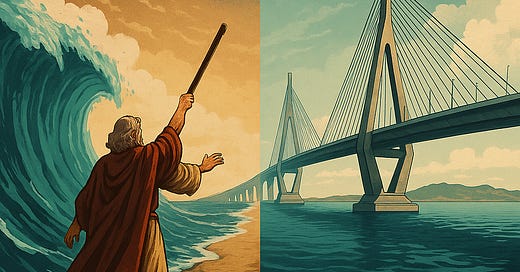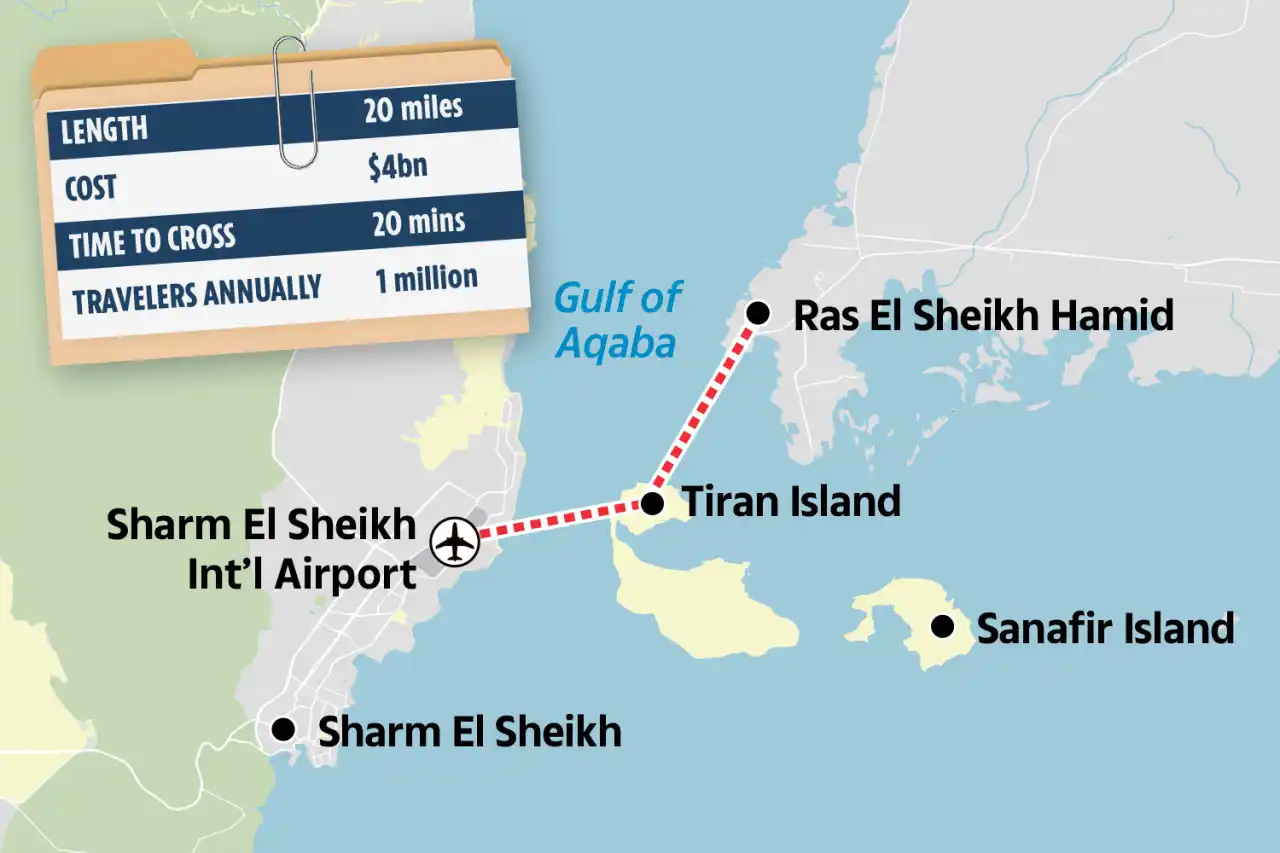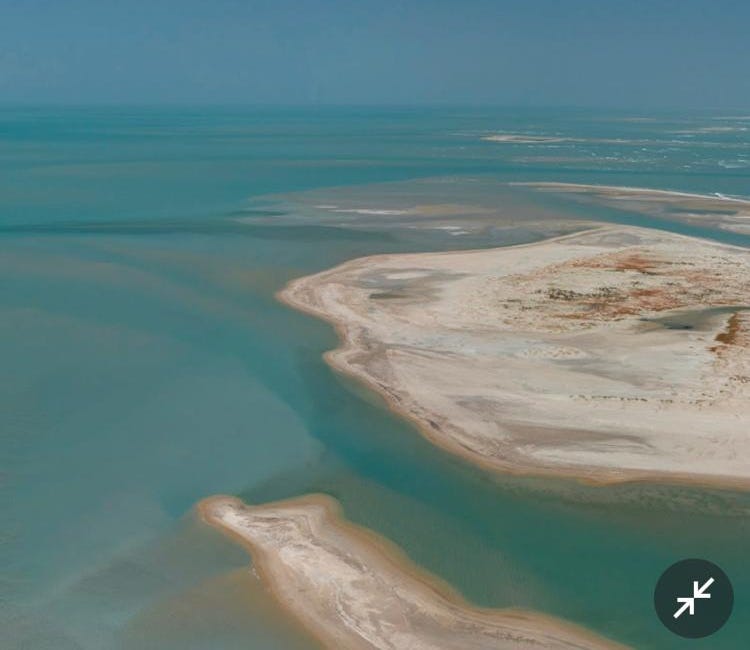Building the Biblical Bridge: Mystical Moses’s Modern Marvel Spans Red Sea
Promising significant economic, social, and diplomatic advantages, the 32 km-long bridge also presents environmental, geopolitical, and social challenges demanding careful management.
Misr's Moment: Moses Bridge Moves Forward
Earlier this week, Egypt’s Transport Minister Kamel El-Wazir confirmed that all planning for the long-anticipated Red Sea bridge—popularly known as the “Moses Bridge”—has been completed. Egypt stands ready to commence the project “at any time,” pending only a final political decision. The 32-kilometre-long bridge, potentially incorporating a tunnel, will connect Sharm El-Sheikh on Egypt's Sinai Peninsula to Ras Alsheikh Hamid in Saudi Arabia, traversing the Red Sea via Tiran Island.
Fully financed by Saudi Arabia at an estimated cost of $4 billion, the bridge is poised to become a vital corridor for trade, tourism, and pilgrimage, and will be seamlessly integrated into the Kingdom’s NEOM project. NEOM, short for 'New Enterprise Operating Model', is a futuristic mega-city envisioned under Saudi Arabia’s Vision 2030. The name blends the Greek prefix 'Neo' (meaning 'new') and the Arabic word 'Mustaqbal' (meaning 'future'), symbolising a 'new future' for the Kingdom. The project is expected to support over one million passengers annually and facilitate faster overland trade between Africa and Asia.
This ambitious effort contrasts notably with another high-profile infrastructure project: the modern "Ram Setu" bridge between India and Sri Lanka. Despite repeated proposals and significant discussions, political sensitivities, environmental concerns, and economic factors have continually stalled progress, leaving the project largely unrealised.
The First Modern Proposal (1988–2016)
The concept of a fixed connection between Egypt and Saudi Arabia emerged in 1988 when Egyptian officials first proposed the Red Sea bridge to enhance trade, tourism, and pilgrimage logistics. Despite its strategic appeal, political and security concerns—including objections from Israel regarding control over the Strait of Tiran—led to repeated delays. Revived significantly in 2016 with the endorsement of Saudi King Salman and Egyptian President Abdel Fattah el-Sisi, the bridge was initially proposed as the "King Salman bin Abdulaziz Bridge." However, the name "Moses Bridge" became popularly adopted, evoking the powerful symbolism of the biblical crossing of the Red Sea.
Moses in History and Mythology
The Moses Bridge draws symbolic inspiration from the story of Moses, an iconic figure in Judaism, Christianity, and Islam. According to the Book of Exodus, Moses led the Israelites out of Egyptian slavery, miraculously parting the Red Sea to allow safe passage. The sea then closed over Pharaoh's pursuing army. This profound narrative of deliverance and divine intervention underpins the bridge’s symbolic representation as a modern-day connection and a metaphor for overcoming barriers.
Finances and Project Scope
Saudi Arabia, under its Vision 2030 initiative, will fully finance the $4 billion Moses Bridge. The project aims to diversify the Kingdom’s economy and enhance its global logistics and tourism sectors. Spanning approximately 32 kilometres, the bridge will accommodate both road and high-speed rail transport, directly connecting to the NEOM mega-city. Toll revenues from passengers, freight, and pilgrims are projected to recoup the project's cost within a decade.
Advantages for Both Countries
Saudi Arabia:
Boosts Vision 2030 goals, enhancing tourism, logistics, and economic diversification.
Direct connection between NEOM and Africa, significantly increasing regional influence.
Efficient route for Muslim pilgrims to Mecca, potentially serving over a million annually.
Egypt:
Strengthens Egypt’s position as a regional logistics and tourism hub, especially in the strategic Sinai region.
Stimulates economic growth, job creation, and infrastructure development in Sinai and Sharm El-Sheikh.
Improves access to Gulf markets and regional rail networks.
Joint Advantages:
Enhances diplomatic and economic relations.
Reduces dependency on maritime routes like the Suez Canal for regional trade.
Symbolises strengthened cross-continental cooperation and increased mobility. The anticipated high passenger volume and improved overland trade further underline the project's significance.
Disadvantages and Environmental Concerns
Despite its numerous benefits, the Moses Bridge faces several significant challenges:
Environmental Risks: The ecologically delicate Strait of Tiran supports coral reefs, endangered dugongs, and critical nesting habitats for turtles and seabirds. Environmentalists caution against potential irreversible ecological harm, urging thorough environmental assessments and eco-sensitive design solutions, possibly including hybrid bridge-tunnel structures.
Security and Geopolitical Issues: The strategic sensitivity of the region, historical objections from Israel, and maritime sovereignty concerns under the Camp David Accords require careful diplomatic management and sustained political cooperation.
Social Concerns: Large infrastructure developments, such as NEOM and the Moses Bridge, have drawn criticism for displacing local communities, particularly the Howeitat tribe, raising ongoing human rights and compensation issues.
Technical and Financial Risks: Engineering complexities of bridging the Red Sea present substantial technical challenges, while sustained operational and maintenance costs require effective project management and political stability.
Bridging His_story
Now fully planned and awaiting political endorsement, the Moses Bridge embodies decades of negotiation, historical symbolism, and strategic foresight. While it promises significant economic, social, and diplomatic benefits, it also faces environmental, geopolitical, and societal challenges that require careful navigation. As this ambitious undertaking advances, it stands as a powerful testament to both the enduring pull of history and the contemporary drive for connectivity and regional transformation. In contrast, the long-stalled Ram Setu project between India and Sri Lanka underscores the complexities inherent in such international infrastructure ventures—highlighting the scale of achievement should the Moses Bridge come to fruition.
India and Sri Lanka on Verge of Approving $5 Billion 'New Ram Setu' Road-and-Rail Link
Optimism for the $5 Billion Dream Project






